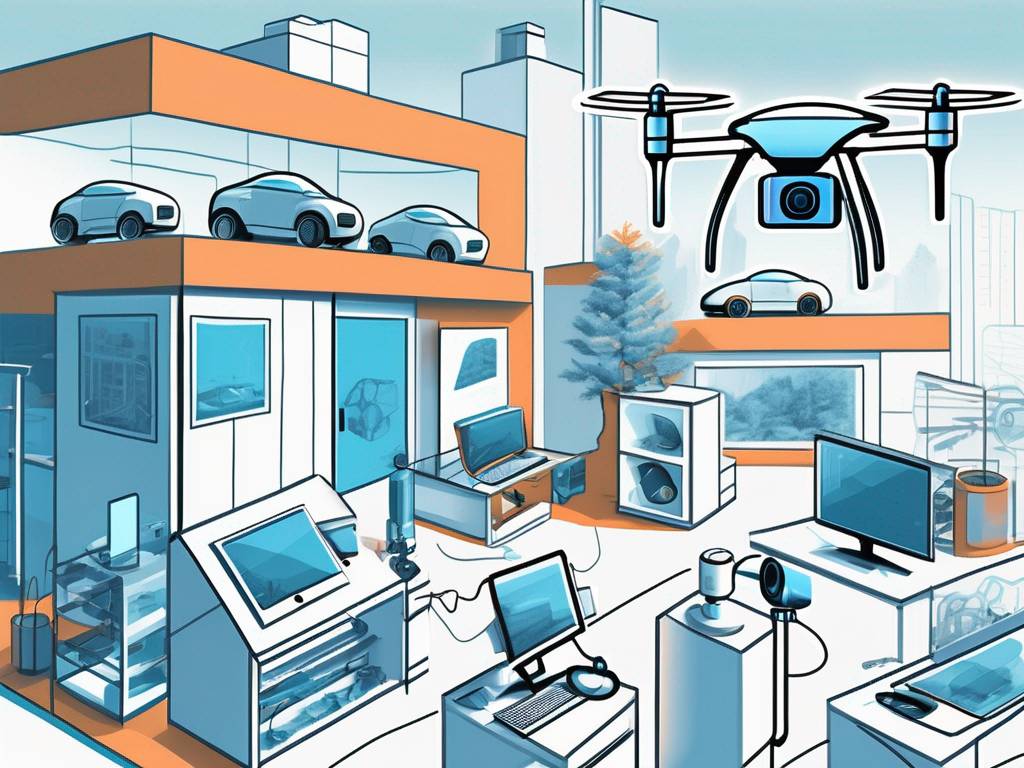Key Insights
- Wearable AI refers to the integration of artificial intelligence technology into devices that can be worn on the body
- The concept of wearable AI has evolved over time, from simple activity trackers to sophisticated smartwatches and augmented reality glasses
- The technology behind wearable AI involves sensor data collection, machine learning algorithms, and real-time data processing
- Wearable AI has various applications in healthcare, fitness, entertainment, and other industries, improving personal well-being and enhancing user experiences
Understanding the Concept of Wearable AI
Wearable AI is a groundbreaking technology that combines the power of artificial intelligence with everyday wearable devices. It opens up new possibilities for users by transforming ordinary accessories into smart companions that provide valuable insights and enhance decision-making processes. By utilizing advanced AI algorithms and sensors, wearable AI devices can collect data, analyze it in real-time, and generate personalized feedback. This guide aims to explore the key aspects of wearable AI, from its definition to its impact on daily life and the future of wearable technology.
Definition of Wearable AI
Wearable AI, also known as AI wearables, refers to the integration of artificial intelligence technology into wearable devices that individuals can wear on their bodies. These devices are equipped with built-in sensors and software algorithms that interpret collected data to provide advanced functionalities and personalized experiences. Unlike traditional wearables, such as fitness trackers, wearable AI devices possess the capability to perform complex tasks, learn from user interactions, and adapt to individual needs.
The Evolution of Wearable AI
The evolution of wearable AI can be traced back to the early development of basic activity trackers that monitored steps and calories burned. Over time, wearables expanded to include heart rate monitors, sleep trackers, and GPS functionalities. These advancements laid the foundation for wearable AI devices by demonstrating the potential for collecting and analyzing user data.
Wearable AI has evolved to include advanced features such as voice recognition, gesture control, and augmented reality, transforming wearables into smart companions across various sectors. Breakthroughs in artificial intelligence and miniaturization have enabled these devices to perform complex tasks and provide instant feedback, helping users improve lifestyle habits through intelligent notifications and adaptive interfaces.
The Technology Behind Wearable AI
Wearable tech involves a sophisticated combination of hardware and software components. These components work seamlessly together to collect, process, and interpret data, enabling wearables to deliver advanced functionalities and intelligent insights.
How Wearable AI Works
At its core, wearable AI relies on sensors to gather data about the user’s environment and physical activities. These devices employ data mining, a comprehensive process that uses machine learning methods, deep learning, time series analysis, and cluster analysis, to sift and analyze data for meaningful insights, patterns, and trends. These algorithms detect anomalies and make predictions based on the collected information. The algorithms also continuously learn from user interactions and adapt to individual preferences, resulting in more accurate and personalized experiences over time.
Key Components of Wearable AI
Wearable AI devices consist of several key components that contribute to their functionality and intelligence. These include:
- Sensors: Wearable AI devices are equipped with a wide range of sensors, such as accelerometers, gyroscopes, heart rate monitors, and GPS modules. These sensors gather data about the user’s movements, physiological states, and location.
- Processor: A powerful processor is essential for wearable AI devices to handle real-time data processing and execute complex algorithms efficiently.
- Connectivity: Wearable AI devices often have built-in wireless connectivity, such as Bluetooth or Wi-Fi, to enable seamless communication with other devices and services.
- User Interface: Intuitive user interfaces, including touchscreens, voice recognition, and gesture control, allow users to interact with wearable AI devices effortlessly.
- Power Management: To ensure prolonged usage, wearable AI devices come with optimized power management solutions, such as energy-efficient components and intelligent battery management systems.
Different Types of Wearable AI
Wearable AI technology has found applications across various industries, revolutionizing the way individuals interact with their surroundings and enhancing their daily lives. Some of the prominent types of wearable AI devices include those used in healthcare, fitness, and entertainment.
AI Wearables in Healthcare
In the healthcare sector, wearable AI devices have the potential to transform patient care by providing real-time health monitoring and personalized recommendations based on medical data. These devices can track vital signs, monitor blood oxygen levels, detect anomalies, and alert healthcare professionals in case of emergencies. Wearable AI also enables individuals to take proactive control of their health in everyday life, as it provides insights into daily activities, sleep patterns, and stress levels, allowing users to make informed decisions about their health.
AI Wearables in Fitness
For fitness enthusiasts, wearable AI devices offer intelligent coaching and performance tracking capabilities. These devices can provide real-time feedback on exercise techniques, heart rate, and calorie burn, allowing users to optimize their workouts to achieve their fitness goals. Wearable AI devices can also monitor sleep quality and recovery, enabling individuals to make data-driven adjustments to their routines for better overall performance.
AI Wearables in Entertainment
The entertainment industry has also embraced the potential of wearable AI devices. Augmented reality and smart glasses, for example, enhance user experiences by overlaying digital information onto the real world. This opens up new possibilities for interactive gaming, immersive storytelling, and virtual travel experiences. Wearable AI technology in the entertainment sector is constantly evolving, promising exciting innovations and immersive experiences.
The Impact of Wearable AI on Daily Life
Wearable AI has a profound impact on individuals’ daily lives, offering various personal benefits and influencing societal dynamics.
Personal Benefits of Wearables
Wearable AI devices empower individuals with personalized insights and intelligent functionalities that enhance their overall well-being. Users can gain a deeper understanding of their health, increase their fitness levels, and make informed decisions based on real-time alerts and feedback. Additionally, wearable AI devices can assist in time management, provide reminders, and improve productivity, allowing users to achieve a better work-life balance.
Societal Implications of Wearables
As wearable AI becomes more prevalent, it raises important societal implications. Privacy concerns arise due to the vast amount of personal data collected by wearable AI devices. Issues related to data security, data ownership, and consent must be addressed to ensure user trust. Wearable AI has the potential to exacerbate existing inequalities, as access to advanced technologies may be limited to certain demographics or socioeconomic groups. It is crucial to create an inclusive environment that benefits all individuals regardless of their background or resources.
The Future of Wearable AI
The future of wearable AI is promising, with emerging trends and advancements poised to reshape various industries and transform user experiences.
Emerging Trends in Wearable Technology
One of the emerging trends in wearable AI is the integration of biometric sensors that can continuously monitor a wider range of health parameters, such as blood glucose levels, hydration levels, and stress levels. This would enable individuals to proactively manage their health and receive timely interventions when necessary. AI-powered wearables are becoming more fashion-forward, with companies focusing on designing aesthetically pleasing wearables that seamlessly blend with personal style.
Potential Challenges & Solutions for Wearable AI
While wearable AI holds great promise, there are potential challenges that need to be addressed as the technology progresses. These challenges include battery life limitations, data privacy concerns, and user acceptance. To mitigate these challenges, advancements in energy-efficient hardware, robust data encryption techniques, and transparent user consent processes need to be developed. Collaboration between industry leaders, policymakers, and consumer advocacy groups is crucial to ensure ethical and responsible advancements in wearable AI.
As C-level executives in the industry, it is imperative to stay ahead of the curve and recognize the transformative potential of wearable AI. By embracing this technology, companies can leverage the wealth of data generated by wearable AI devices to gain valuable insights about consumer behaviors, preferences, and needs. In turn, this knowledge can drive innovation, enhance customer experiences, and unlock new business opportunities. To fully harness the power of wearable AI, C-level executives must foster a culture of adaptability, innovation, and ethical practices within their organizations.
Questions?
-
What is a wearable device and how does it differ from a traditional wearable?Toggle questionWearable AI refers to wearable devices that incorporate AI technologies to enhance their capabilities. Unlike traditional wearables that primarily collect and display data, wearable AI devices leverage artificial intelligence to analyze data, provide personalized insights, and make intelligent recommendations.
-
What are some examples of wearable AI devices?Toggle questionSome examples of wearable AI available on the market include the CZ Smart Smartwatch, Humane Ai Pin, Oura Ring Generation 3, and Google Glass.
-
How does AI enhance the functionality of wearable devices?Toggle questionAI enhances wearable devices by enabling them to understand user patterns, make predictions, and offer personalized experiences. It can analyze health data for more accurate insights, provide real-time contextual information, and adapt to user preferences over time.
-
Are all smartwatches and fitness trackers considered wearable AI devices?Toggle questionNot necessarily. While many smartwatches and fitness trackers have basic AI features, true wearable AI devices go beyond simple data collection. They use advanced AI algorithms to process and interpret data, offering more intelligent and personalized functionalities.
-
What role does machine learning play in wearable AI?Toggle questionMachine learning is a key component of wearable AI. It enables devices to learn from user behavior, adapt to preferences, and improve their functionality over time.
-
How does wearable AI impact health and fitness tracking?Toggle questionWearable AI revolutionizes health and fitness tracking by providing more accurate and personalized insights. It can analyze complex health data, detect patterns, and offer tailored recommendations for fitness routines, sleep improvement, and overall well-being.
-
Are there privacy concerns associated with wearable AI?Toggle questionYes, privacy is a consideration. As wearable AI devices collect and process personal data, there are concerns about data security and user privacy. It's crucial for manufacturers to implement robust security measures and transparent privacy policies.
-
Can wearable AI be integrated into other industries, apart from health and fitness?Toggle questionAbsolutely! In addition to health and fitness, wearable AI can be utilized in augmented reality for immersive experiences, in industrial settings for worker safety, and in retail for personalized customer interactions.
-
How is the battery life of wearable devices affected by AI processing?Toggle questionThe impact on battery life depends on the complexity of AI processing and the efficiency of device design. Manufacturers aim to balance advanced AI functionalities with energy efficiency to ensure reasonable battery life for daily usage.
-
Are wearable AI devices suitable for all age groups?Toggle questionWearable AI devices can be designed for different age groups and purposes. From elderly care for seniors to fitness tracking for young adults, there's potential for customization to meet the diverse needs of users.
-
What does the future hold for wearable technology?Toggle questionThe future of wearable AI is promising. Continued advancements in AI algorithms, miniaturization of hardware, and the integration of innovative sensors are expected. This will lead to even smarter, more intuitive wearable AI devices with expanded capabilities.

 hello@westlink.com
hello@westlink.com  (866) 954-6533
(866) 954-6533  700 N Colorado Blvd,
700 N Colorado Blvd,







Comments